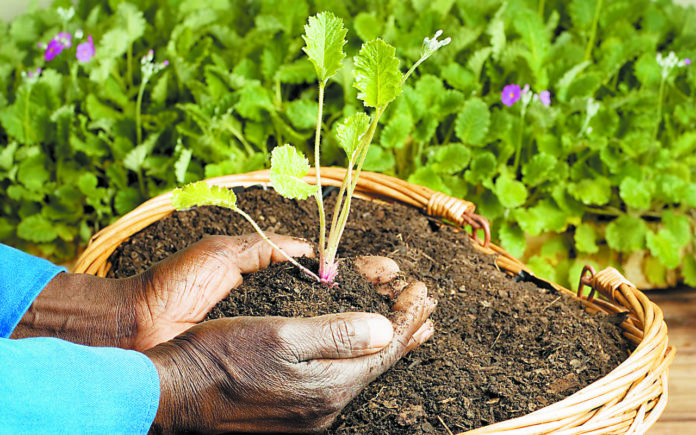To me, the beautiful thing about planting seeds is that in the presence of the proper conditions – good light, good seed, good soil and good water – literally anyone can succeed.

At the risk of stating the obvious, the health of your soil will have everything to do with how your garden grows. Not all soils are the same, and some are better suited to different types of plants.
Ideally, you’d want a “loam” type of soil, that’s an excellent mixture of humus soil (that’s that GOOD, BLACK soil), clay and sand. Here in the Mid-South (Zone 7A), it’s not uncommon to have a soil with a heavy clay component.
When people think of the back-breaking work of breaking up soil to plant something, this is the reason why. This is that “hard earth” that when you hit it with a shovel, it feels like it’s hitting you back.
Some clay is fine, maybe even desirable. But the problem is that when it gets wet, it clumps together, making it harder for the sprout to grow into deep roots. Also, clay isn’t known for its nutrients either, so there’s that.
I’m not saying you can’t grow in this type of soil, but the work will be harder, the plant will not be as robust as it otherwise could be, and all of that means a less fruitful harvest.
And if you’re just starting out, a less fruitful garden doesn’t give you the boost of confidence you need to know that you can succeed at this gardening thing. The trick then is to make sure your soil is healthy and optimal for growing.
If you’re super serious about getting your garden right, you can always have your soil tested. Many states, including Tennessee, offer soil testing for a fee. The test checks multiple submitted samples for all kinds of nutrients and micronutrients for crop success. Armed with that knowledge, you’d know exactly what you need to do to optimize your soil.
Most home gardeners are not growing at a scale – that is, to sell at market – where that type of testing is essential. If you understand a few basic principals, you’ll be able to amend your soil just fine. Check these out:
Organic matter: Here’s a funny side effect of how a little bit of knowledge changes your perspective: I can’t look at bagged leaves by the side of the road without wishing I had a truck to pick them up.
Why? Because as those bagged leaves decompose over time, it will become that black humus soil I mentioned earlier. Have you ever had a pile of leaves sit too long and then when you move it, you notice there’s black soil there? That’s why!
If you have leaves in your own yard, use ’em. If your neighbor has bagged leaves on the curb, use ’em! And quiet as it’s kept, you don’t have to wait for it to break down – you can actually plant seeds in the leaf mulch.
Manure: Any farmer will tell you that manure – cow, horse, goat, chicken – helps contribute to soil health. Some people invite their chicken farmer friends over to let the yardbird scratch around – which naturally mixes in their poop into the soil, thank you.
If you have a small garden, it might be easiest just to buy it at a local nursery or garden shop. But cattle farmers and horse owners often will give the manure away.
Here in Memphis, take a cruise through the Carriage District on North Second Street. That’s where the stables for the horse and carriage drivers go and sure enough you’ll see the sign: “Free manure.”
Worms. If you’ve already got worms in your yard, congratulations! That’s a sign of healthy soil! Earthworms eat their way through the organic matter, leaving their casings as they go – the kind of slimy stuff you’ll see on their trail. Well, those casings are chock full of the nutrients plants need to grow, so the more worms the better!
But where? Well, you could go digging for them. Or you could be lazy like I was and find a fish-and-tackle shop. That’s where I picked up a couple dozen red crawlers for just a couple of bucks.
Perlite or twigs: One of the things we’re trying to create here in amending the soil is space – space for water to move, space for the root to go where it needs to go, space for the roots to get some oxygen. That’s why too much clay in your soil is bad.
Some home gardeners use perlite in their soil. Perlite (the little white rocks) offers no nutritional benefit, but is there to help aerate the soil. Then again, nature had all this figured out before perlite.
As you’re mixing the leaves and manure into your soil, also make sure to mix in a few larger pieces of brush – think twigs, limbs, even branches. And, of course, wood chips. The object here is that these things will decompose at different rates over time – which will help aerate your soil while steadily making your soil that much more fertile for years to come.
The bottom line is that with those key ingredients, you can pretty much MAKE high quality fertile growing medium that you can use to enhance your plot of land or use in raised beds. And once you’ve got good soil . . . it’s time to grow.
Are YOU a gardener or urban farmer in Memphis? Do you know one? Do you have a specific question or problem with your garden that you need help with? If you answered yes to any of those, email me at lesmith@tsdmemphis.com!
(Lee Eric Smith is an NNPA award-winning columnist and co-founder of Abundant Earth Global CDC, a nonprofit aimed at blending eco-friendly home construction, urban farming and waste-to-energy production to regenerate neighborhoods. Follow him on Twitter and Instagram: @l3esmith.)



